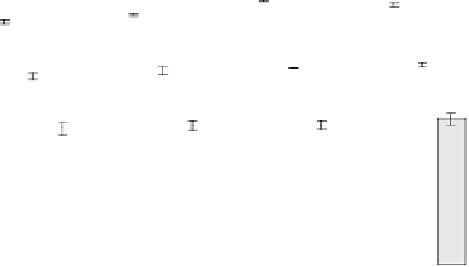Biomedical Engineering Reference
In-Depth Information
(stretching velocity: 0.3
mm/s, shape of specimen: JIS Z2201). After
measuring stresses and strains of 15 scaffolds, Young's modulus of
each scaffold was calculated using
s
Pl
E
ss
(8.1)
E
ltd
where
E
,
P
,
l
,
E
l
,
t
, and
d
are the Young's modulus, stress, length,
variation of length, thickness, and width of the sheet, respectively. At
each experimental condition, six samples were measured to obtain
standard deviation (SD). Therefore, 90 (5
×
3
×
6) samples were
tested.
10000
PLCL 10w% in Chloroform
PLCL 5w% in Chloroform
PLCL 3w% in Chloroform
1000
100
10
1
1
2
3
4
Pulling-up speed (mm/s)
Figure 8.5
Relation between pull-up velocity and thickness of dip-coated
PLCL membrane (
n
= 5 for each bar, vertical axis : logarithmic
scale, PLCL : NaCl = 6 : 4
wt%).
Figure 8.6 shows an experimental setup used to measure Young's
modulus. A commercial dip coater was modiied to be a tensile tester
by attaching a load cell. The load cell was connected to a force gage,
which was also connected to a laptop. The pull-up motion of a dip
coater was used to stretch specimens of PLCL sheet-like scaffolds
(pull-up speed: 0.1
mm/s). Time series variation of tensile force was
recorded in PC and was subsequently converted into a stress-strain
curve. Specimens were stretched until the tensile force reached 5
N.









































































Search WWH ::

Custom Search